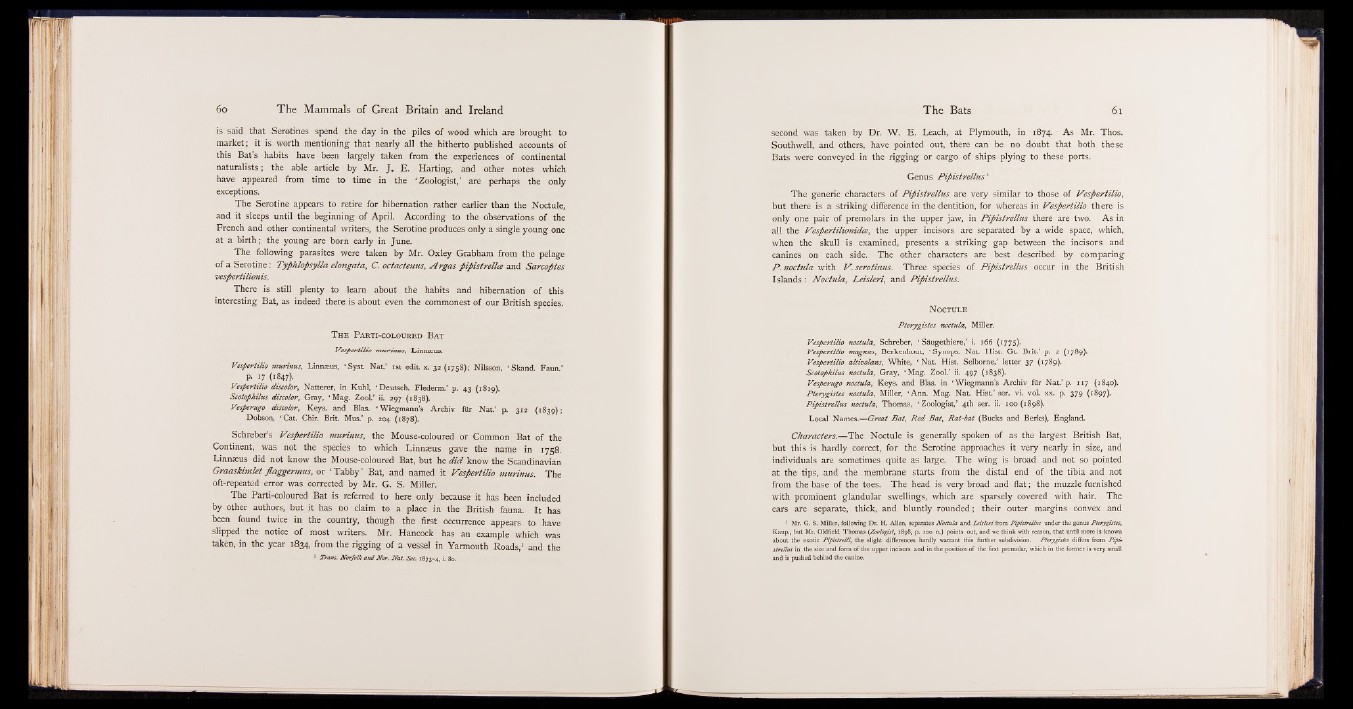
is said that Serotines spend the day in the piles of wood which are brought to
market; it is worth mentioning that nearly all the hitherto published accounts of
this Bat’s habits have been largely taken from the experiences of continental
naturalists; the able article by Mr. J. E. Harting, and other notes which
have appeared from time to time in the ‘ Zoologist,’ are perhaps the only
exceptions.
The Serotine appears to retire for hibernation rather earlier than the Noctule,
and it sleeps until the beginning of April. According to the observations of the
French and other continental writers, the Serotine produces only a single young one
at a birth; the young are born early in June.
The following parasites were taken by Mr. Oxley Grabham from the pelage
of a Serotine: Typhlopsylla elongata, C. octactenus, Argas pipistrelles and Sarcoptes
vespertilionis.
There is still plenty to learn about the habits and hibernation of this
interesting Bat, as indeed there is about even the commonest of our British species.
T h e P a r t i - c o l o u r e d B a t
Vespertilio murinus, Linnaeus.
Vespertilio murinus, Linnaeus, ‘ S y s t Nat.’ ist edit x. 32 (1758); Nilsson, ‘ Skand. Faun.’
p. 17 (1847).
Vespertilio discolor, Natterer, in Kuhl, ‘ Deutsch. Flederm.’ p. 43 (1819).
Scotophilus discolor, Gray, ‘ Mag. Zool.’ ii. 297 (1838).
Vesperugo discolor, Keys, and Bias. ‘ Wiegmann’s Archiv fUr N a t ’ p. 312 {1839);
Dobson, ‘ Cat. Chir. B r it Mus.’ p. 204 (1878).
Schreber’s Vespertilio murinus, the Mouse-coloured or Common Bat of the
Continent, was not the species to which Linnaeus gave the name in 1758.
Linnaeus did not know the Mouse-coloured Bat, but he did know the Scandinavian
Graaskimlet flaggermus, or ‘ Tabby ’ Bat, and named it Vespertilio murinus. The
oft-repeated error was corrected by Mr. G. S. Miller.
The Parti-coloured Bat is referred to here only because it has been included
by other authors, but it has no claim to a place in the British fauna. It has
been found twice in the country, though the first occurrence appears to have
slipped the notice of most writers. Mr. Hancock has an example which was
taken, in the year 1834, from the rigging of a vessel in Yarmouth Roads,1 and the
1 Trans. Norfolk and Nor. Nat. Soc. 1873-4, i. 80.
second was taken by Dr. W. E. Leach, at Plymouth, in 1874. As Mr. Thos.
Southwell, and others, have pointed out, there can be no doubt that both these
Bats were conveyed in the rigging or cargo of ships plying to these ports.
Genus Pipistrellus1
The generic characters of Pipistrellus are very similar to those of Vespertilio,
but there is a striking difference in the dentition, for whereas in Vespertilio there is
only one pair of premolars in the upper jaw, in Pipistrellus there are two. As in
all the Vespertilionidce, the upper incisors are separated by a wide space, which,
when the skull is examined, presents a striking gap between the incisors and
canines on each side. The other characters are best described by comparing
P. noctula with V . serotinus. Three species of Pipistrellus occur in the British
Islands: Noctula, Leisleri, and Pipistrellus.
N o c t u l e
Pterygistes noctula, Miller.
Vespertilio noctula, Schreber, * Saugethiere,’ i. 166 ( 1775)-
Vespertilio magnus, Berkenhout, ‘ Synops. Nat. Hist. Gt. Brit.’ p. 2 (1789).
Vespertilio altivolans, White, ‘ Nat. Hist. Selborne,’ letter 37 (1789).
Scotophilus noctula, Gray, ‘ Mag. Zool.’ ii. 497 (1838).
Vesperugo noctula, Keys, and Bias, in ‘Wiegmann’s Archiv flir Nat.’ p. 117 (1840).
Pterygistes noctula, Miller, ‘ Ann. Mag. Nat. Hist.’ ser. vi. vol. xx. p. 379 (1897).
Pipistrellus noctula, Thomas, ‘ Zoologist,’ 4th ser. ii. 100(1898).
Local Names.— Great Bat, R ed Bat, Rat-bat (Bucks and Berks), England.
Characters.— The Noctule is generally spoken of as the largest British Bat,
but this is hardly correct, for the Serotine approaches it very nearly in size, and
individuals are sometimes quite as large. The wing is broad and not so pointed
at the tips, and the membrane starts from the distal end of the tibia and not
from the base of the toes. The head is very broad and flat; the muzzle furnished
with prominent glandular swellings, which are sparsely covered with hair. The
ears are separate, thick, and bluntly rounded; their outer margins convex and
1 Mr. G. S. Miller, following Dr. H. Allen, separates Noctula and Leisleri from Pipistrellus under the genus Pterygistes,
Kaup., but Mr. Oldfield Thomas (Zoologist, 1898, p. 100 n.) points out, and we think with reason, that until more is known
about the exotic Pipistrelli, the slight differences hardly warrant this further subdivision. Pterygistes differs from Pipistrellus
in the size and form of the upper incisors and in the position o f the first premolar, which in the former is very small
and is pushed behind the canine.